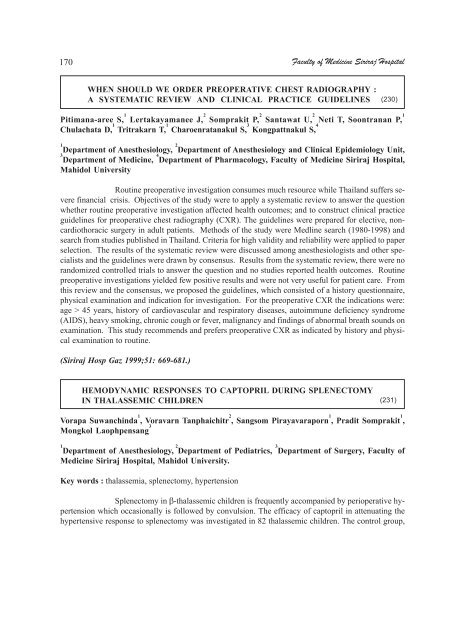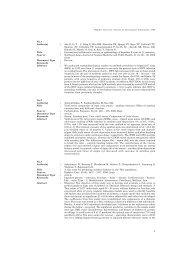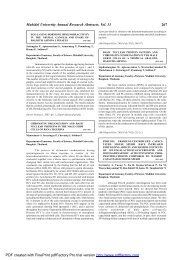THE OSTIA VENAE HEPATICAE AND THE RETHROHEPATIC ...
THE OSTIA VENAE HEPATICAE AND THE RETHROHEPATIC ...
THE OSTIA VENAE HEPATICAE AND THE RETHROHEPATIC ...
Create successful ePaper yourself
Turn your PDF publications into a flip-book with our unique Google optimized e-Paper software.
170<br />
WHEN SHOULD WE ORDER PREOPERATIVE CHEST RADIOGRAPHY :<br />
A SYSTEMATIC REVIEW <strong>AND</strong> CLINICAL PRACTICE GUIDELINES<br />
Pitimana-aree S, 1<br />
Lertakayamanee J, 2<br />
Somprakit P, 2<br />
Santawat U, 2<br />
Neti T, Soontranan P, 1<br />
Chulachata D, 1<br />
Tritrakarn T, 1<br />
Charoenratanakul S, 3<br />
Kongpattnakul S, 4<br />
1<br />
Department of Anesthesiology, 2<br />
Department of Anesthesiology and Clinical Epidemiology Unit,<br />
3<br />
Department of Medicine, 4<br />
Department of Pharmacology, Faculty of Medicine Siriraj Hospital,<br />
Mahidol University<br />
Routine preoperative investigation consumes much resource while Thailand suffers severe<br />
financial crisis. Objectives of the study were to apply a systematic review to answer the question<br />
whether routine preoperative investigation affected health outcomes; and to construct clinical practice<br />
guidelines for preoperative chest radiography (CXR). The guidelines were prepared for elective, noncardiothoracic<br />
surgery in adult patients. Methods of the study were Medline search (1980-1998) and<br />
search from studies published in Thailand. Criteria for high validity and reliability were applied to paper<br />
selection. The results of the systematic review were discussed among anesthesiologists and other specialists<br />
and the guidelines were drawn by consensus. Results from the systematic review, there were no<br />
randomized controlled trials to answer the question and no studies reported health outcomes. Routine<br />
preoperative investigations yielded few positive results and were not very useful for patient care. From<br />
this review and the consensus, we proposed the guidelines, which consisted of a history questionnaire,<br />
physical examination and indication for investigation. For the preoperative CXR the indications were:<br />
age > 45 years, history of cardiovascular and respiratory diseases, autoimmune deficiency syndrome<br />
(AIDS), heavy smoking, chronic cough or fever, malignancy and findings of abnormal breath sounds on<br />
examination. This study recommends and prefers preoperative CXR as indicated by history and physical<br />
examination to routine.<br />
(Siriraj Hosp Gaz 1999;51: 669-681.)<br />
HEMODYNAMIC RESPONSES TO CAPTOPRIL DURING SPLENECTOMY<br />
IN THALASSEMIC CHILDREN<br />
Vorapa Suwanchinda 1<br />
, Voravarn Tanphaichitr 2<br />
, Sangsom Pirayavaraporn 1<br />
, Pradit Somprakit 1<br />
,<br />
Mongkol Laophpensang 3<br />
1<br />
Department of Anesthesiology, 2<br />
Department of Pediatrics, 3<br />
Department of Surgery, Faculty of<br />
Medicine Siriraj Hospital, Mahidol University.<br />
Key words : thalassemia, splenectomy, hypertension<br />
Faculty of Medicine Siriraj Hospital<br />
Splenectomy in β-thalassemic children is frequently accompanied by perioperative hypertension<br />
which occasionally is followed by convulsion. The efficacy of captopril in attenuating the<br />
hypertensive response to splenectomy was investigated in 82 thalassemic children. The control group,<br />
(230)<br />
(231)

















